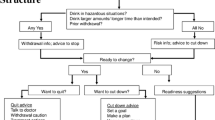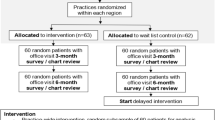Abstract
OBJECTIVE: This study describes primary care discussions with patients who screened positive for at-risk drinking. In addition, discussions about alcohol use from 2 clinic firms, one with a provider-prompting intervention, are compared.
DESIGN: Cross-sectional analyses of audiotaped appointments collected over 6 months.
PARTICIPANTS AND SETTING: Male patients in a VA general medicine clinic were eligible if they screened positive for at-risk drinking and had a general medicine appointment with a consenting provider during the study period. Participating patients (N=47) and providers (N=17) were enrolled in 1 of 2 firms in the clinic (Intervention or Control) and were blinded to the study focus.
INTERVENTION: Intervention providers received patient-specific results of positive alcohol-screening tests at each visit.
MEASURES AND MAIN RESULTS: Of 68 visits taped, 39 (57.4%) included any mention of alcohol. Patient and provider utterances during discussions about alcohol use were coded using Motivational Interviewing Skills Codes. Providers contributed 58% of utterances during alcohol-related discussions with most coded as questions (24%), information giving (23%), or facilitation (34%). Advice, reflective listening, and supportive or affirming statements occurred infrequently (5%, 3%, and 5%, of provider utterances respectively). Providers offered alcohol-related advice during 21% of visits. Sixteen percent of patient utterances reflected “resistance” to change and 12% reflected readiness to change. On average, Intervention providers were more likely to discuss alcohol use than Control providers (82.4% vs 39.6% of visits; P=.026).
CONCLUSIONS: During discussions about alcohol, general medicine providers asked questions and offered information, but usually did not give explicit alcohol-related advice. Discussions about alcohol occurred more often when providers were prompted.
Similar content being viewed by others
References
Grant BF, Harford TC, Dawson DA, Chou P, Dufour M, Pickering R. Prevalence of DSM-IV alcohol abuse and dependence, United States, 1992. Alcohol Health Res World. 1994;18:243–8.
Institute of Medicine. Broadening the Base of Treatment for Alcohol Problems: A Report of the Committee for the Study of Treatment and Rehabilitation for Alcoholism. Washington DC: National Academy Press; 1990.
Secretary of Health and Human Services. Ninth Special Report to the US Congress on Alcohol and Health. Arlington, Va: Department of Health and Human Services; 1997.
Hasin D, Grant B, Dufour M, Endicott J. Alcohol problems increase while physician attention declines. Arch Intern Med. 1990;150:397–400.
Fleming MF, Barry KL, Manwell LB, Johnson K, London R. Brief physician advice for problem alcohol drinkers: a randomized controlled trial in community-based primary care practices. JAMA. 1997;277:1039–45.
Ockene JK, Adams A, Hurley TG, Wheeler EV, Hebert JR. Brief physician- and nurse practitioner-delivered counseling for high-risk drinkers. Arch Intern Med. 1999;159:2198–205.
Wallace P, Cutler S, Haines A. Randomized controlled trial of general practitioner intervention in patients with excessive alcohol consumption. BMJ. 1988;297:663–8.
WHO Brief Intervention Study Group. A cross-national trial of brief interventions with heavy drinkers. Am J Public Health. 1996;86:948–55.
Bien TH, Miller WR, Tonigan S. Brief interventions for alcohol problems: a review. Addiction. 1993;88:315–36.
Richmond R, Heather N, Wodak A, Kehoe L, Webster I. Controlled evaluation of a general practice-based brief intervention for excessive drinking. Addiction. 1995;90:119–32.
Kahan M, Wilson L, Becker L. Effectiveness of physician-based interventions with problem drinkers. Can Med J Assoc. 1995;152:851–9.
Poikolainen K. Effectiveness of brief interventions to reduce alcohol intake in primary health care populations: a meta-analysis. Prev Med. 1999;28:503–9.
Wilk AI, Jensen NM, Havighurst TC. Meta-analysis of randomized control trials addressing brief interventions in heavy alcohol drinkers. J Gen Intern Med. 1997;12:274–83.
National Institute on Alcohol Abuse and Alcoholism. The physician’s guide to helping patients with alcohol problems. Bethesda Md: U.S. Department of Health and Human Services, Public Health Service; National Institutes of Health (NIH publication #95-3769); 1995:1–12.
US Preventive Services Task Force. Guide to Clinical Preventive Services: Report of the US Preventive Services Task Force. 2nd ed. Baltimore: Williams and Wilkins; 1996.
Adams A, Okene JK, Wheele EV, Hurley TG. Alcohol counseling—physicians will do it. J Gen Intern Med. 1998;13:692–8.
Saitz R, Horton NJ, Sullivan LM, Moskowitz MA, Samet JH. Providing physicians with patient-specific information increases the likelihood of alcohol counseling and decreases patient drinking. J Gen Intern Med. 2001;16(suppl):216.
Vinson DC, Elder N, Werner JJ, Vorel LA, Nutting PA. Alcohol-related discussions in primary care—a report from ASPN. J Fam Pract. 2000;49:28–33.
Fihn SD, McDonell MB, Diehr P, Au DH. Routine reporting of health status data does not improve general health or satisfaction. J Gen Intern Med. 2001;16(suppl):132.
Bradley KA, Kivlahan DR, Bush KR, McDonell MB, Fihn SD. Variations on the CAGE alcohol screening questionnaire: strengths and limitations in VA general medical patients. Alcohol Clin Exper Res. 2001;25:1472–8.
Miller WR. Motivational Interviewing Skills Code Manual (MISC). Albuquerque, NM: University of New Mexico; 1998.
Miller WR, Benefield G, Tonigan JS. Enhancing motivation for change in problem drinking: a controlled comparison of two therapist styles. J Consult Clin Psychol. 1993;61:455–61.
Miller WR, Rollnick S, Moyers TB. Motivational Interviewing Professional Training Videotape Series. 1998.
Good P. Permutation Tests. New York: Springer Verlag; 1994.
Volk RJ, Steinbauer JR, Cantor SB. Patient factors influencing variation in the use of preventive interventions for alcohol abuse by primary care physicians. J Stud Alcohol. 1996;57:203–9.
Bradley KA, Bush K, McDonell MB, Malone T, Fihn SD. Screening for problem drinking: comparison of CAGE and AUDIT. J Gen Intern Med. 1998;13:379–88.
Bradley KA, Maynard C, Kivlahan DR, McDonell MB, Fihn SD. The relationship between alcohol screening questionnaires and mortality among male VA outpatients. J Stud Alcohol. 2001; 62:826–33.
Buchsbaum DG, Buchanan RG, Poses RM, Schnoll SH, Lawton MJ. Physician detection of drinking problems in patients attending a general medicine practice. J Gen Intern Med. 1992;7:517–21.
Buchsbaum DG, Buchanan RG, Lawton MJ, Elswick RK Jr, Schnoll SH. A program of screening and prompting improves short-term physician counseling of dependent and nondependent harmful drinkers. Arch Intern Med. 1993;153:1573–7.
Clark WD. Alcohol: an ounce of prevention? J Gen Intern Med. 1995;10:113–4.
Samet JH, Rollnick S, Barnes H. Beyond CAGE: a brief clinical approach after detection of substance abuse. Arch Intern Med. 1996;156:2287–93.
Williams GC, Quill TE, Deci EL, Ryan RM. “The facts concerning the recent carnival of smoking in Connecticut” and elsewhere. Ann Intern Med. 1991;115:59–63.
Walsh DC, Hingson RW, Merrigan DM, et al. The impact of a physician’s warning on recovery after alcoholism treatment. JAMA. 1992;267:663–7.
Roter DL, Hall JA. Physicians’ interviewing styles and medical information obtained from patients. J Gen Intern Med. 1987;2:325–9.
Handmaker NS, Hester RK, Delaney HD. Videotaped training in alcohol counseling for obstetric care practitioners: a randomized controlled trial. Obstet Gynecol. 1999;93:213–8.
Maisto SA, Conigliaro J, McNeil M, Kraemer K, O’Connor M, Kelley ME. Factor structure of the SOCRATES in a sample of primary care patients. Addict Behav. 1999;24:879–92.
Wenrich MD, Paauw DS, Carline JD, Curtis JR, Ramsey PG. Do primary care physicians screen patients about alcohol intake using the CAGE questions? J Gen Intern Med. 1995;10:631–4.
Conigliaro J, Lofgren RP, Hanusa BH. Screening for problem drinking-impact on physician behavior and patient drinking habits. J Gen Intern Med. 1998;13:251–6.
Schorling JB, Klas PT, Willems JP, Everett AS. Addressing alcohol use among primary care patients: differences between family medicine and internal medicine residents. J Gen Intern Med. 1994;9:248–54.
Stange KC, Zyznaski SJ, Smith TF, et al. How valid are medical records and patient questionnaires for physician profiling and health services research? Med Care. 1998;36:851–67.
Rabiner DJ, Branch LG, Sullivan RJ. The receipt of prevention services by veterans using VA versus non-VA facilities. Prev Med. 1998;27:690–6.
Author information
Authors and Affiliations
Corresponding author
Additional information
This research was supported by grants from the University of Washington Royalty Research Fund, and the Department of Veterans Affairs, Health Services Research and Development Service (SDR 96-002). Dr. Bradley is an investigator at the VA Puget Sound Health Care System, and is currently supported by National Institute of Alcohol Abuse and Alcoholism grant no. K23AA00313) and is a Robert Wood Johnson Foundation Generalist Physician Faculty Scholar. Views expressed in this article are those of the authors and do not necessarily represent the views of the Department of Veterans Affairs, the University of Washington, the National Institute of Alcohol Abuse and Alcoholism, or the Robert Wood Johnson Foundation.
Rights and permissions
About this article
Cite this article
Bradley, K.A., Epler, A.J., Bush, K.R. et al. Alcohol-related discussions during general medicine appointments of male VA patients who screen positive for at-risk drinking. J GEN INTERN MED 17, 315–326 (2002). https://doi.org/10.1007/s11606-002-0033-6
Issue Date:
DOI: https://doi.org/10.1007/s11606-002-0033-6




